
The Business of Fashion
Agenda-setting intelligence, analysis and advice for the global fashion community.

Agenda-setting intelligence, analysis and advice for the global fashion community.
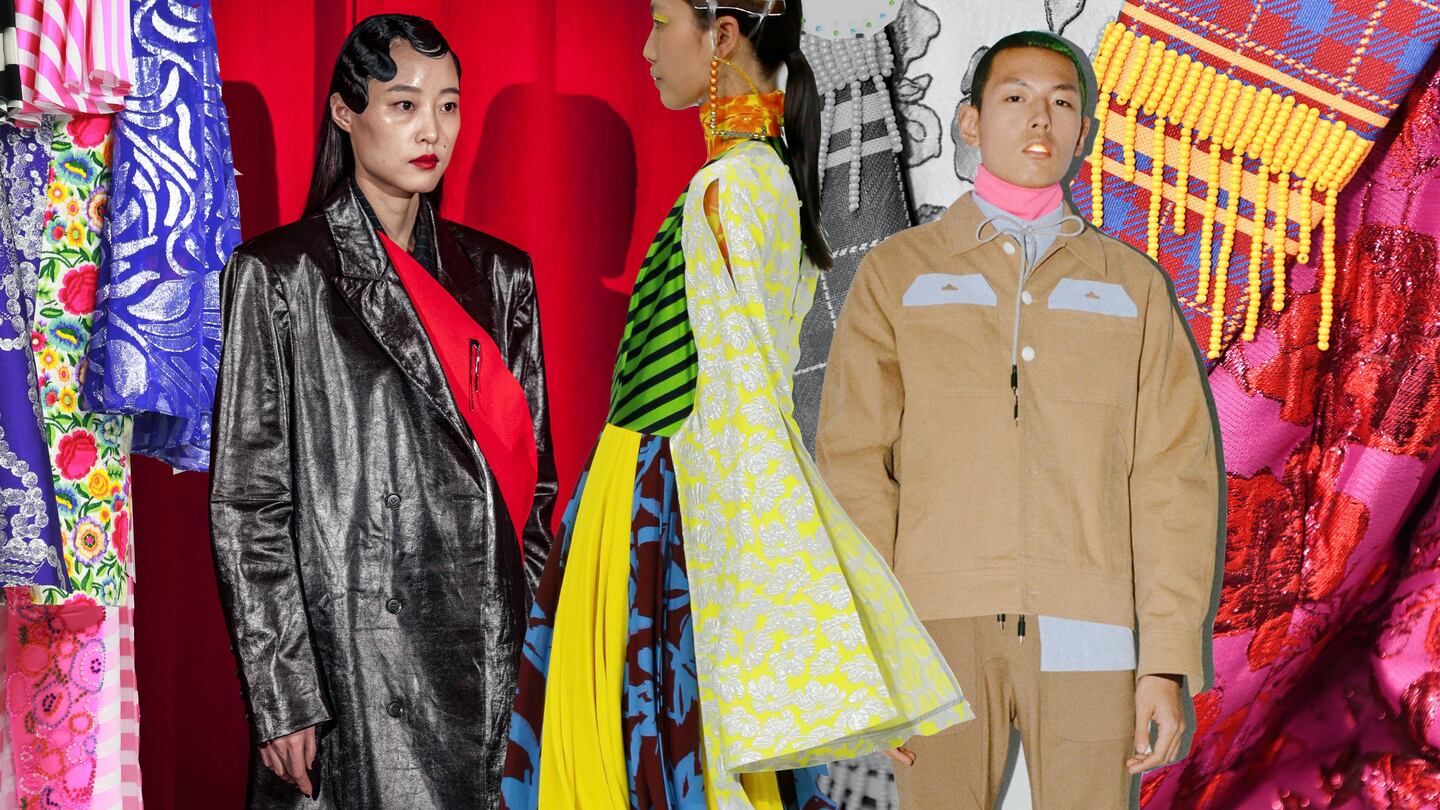
Hello BoF Professionals, welcome to our latest members-only briefing. China’s colossal size and dynamism makes it a top priority for any global business, but it remains opaque to many in the fashion industry. Leveraging our rare access and local knowledge, the BoF China team demystifies the Chinese market with weekly industry analysis and the wider socio-cultural context you need to sharpen your focus.
SHANGHAI, China — Victoria Beckham may not have made it to Shanghai, but by all other metrics the city's fashion week, now in its 17th year, was bigger than ever.
Chinese designer brands are stepping up to take advantage of their intimate understanding of local tastes and desires, demonstrating an ability to connect with their compatriots in ways that are more nuanced, sophisticated and disparate than the generation of designers that came before.
In spite of the fact that so many of them were educated abroad, brands like Staffonly and Ximon Lee showed looks whose resonance in China transcended the familiar globalised signifiers of Chinese identity that trickled down from an earlier generation of designers — Uma Wang, Guo Pei — and the luxury brands who put out limited edition items dedicated to China every Spring Festival.
ADVERTISEMENT
“Young [Chinese] designers are now engaging and critiquing celebrity culture, hyper-consumption on Taobao, image consumption, online in-temporality, the new relation to objects and materiality, dissemination of culture and surveillance capitalism,” said Marie Genevieve Cyr, assistant professor of fashion design at Parsons School of Design, and a regular visitor to China.
This more complex dialogue between Chinese designers and their domestic customers is one that labels and brands outside China, lacking the same cultural context, may struggle to join.
Staffonly, one of the finalists of the BoF China Prize won by Caroline Hu last week, put on a conceptual show at the Tube Showroom runway that pinned Chinese consumer culture like a butterfly. Models stared at their smart phones as they made their way through the space in clothing inspired by e-commerce deliveries.
It's a special language between young designers and their consumers that's more direct and effective.
Puffer jackets, for instance, were stitched vertically to resemble inflatable package filler, while a takeaway bag handle dangled from the storm shield of a trench coat. Yes, there’s Amazon in the US and Asos in the UK, but only in China — the world’s biggest e-commerce market — would this satirical celebration of capitalist capitulation land with such force.
“The fact is, [foreigners] cannot feel the whole atmosphere [here] the way we do,” said Staffonly designer Zhou Shimo. “To mirror the life of Chinese young generation is what we aim for,” she said.
Further complicating the design landscape, contemporary Chinese culture is even more distinct and influential online than it is in real life. Gucci has done phenomenally well with young consumers in China under Alessandro Michele by pushing the boundaries of fashion to accommodate the whole visual cacophony of the World Wide Web. But because of the Great Chinese Firewall, which makes sites such as Instagram and Youtube largely in accessible, China has spawned a parallel digital ecosystem of apps, sites, behaviours and aesthetics that foreign brands may struggle to speak to from abroad.
Chinese contemporary artist Miao Ying refers to the use of “Taobao-style” in her work, a reference not to the products or the process of buying and shipping them that Staffonly references, but the typography, colours and motion graphics used to grab shoppers’ attention on the site.
This overabundance of colour was evident in looks from designers including Angel Chen, who closed indie runway show Labelhood. Chen is among a generation of digital-native creatives whose aesthetics feel augmented by the vibrancy of post-Retina-screen Internet culture in China.
ADVERTISEMENT
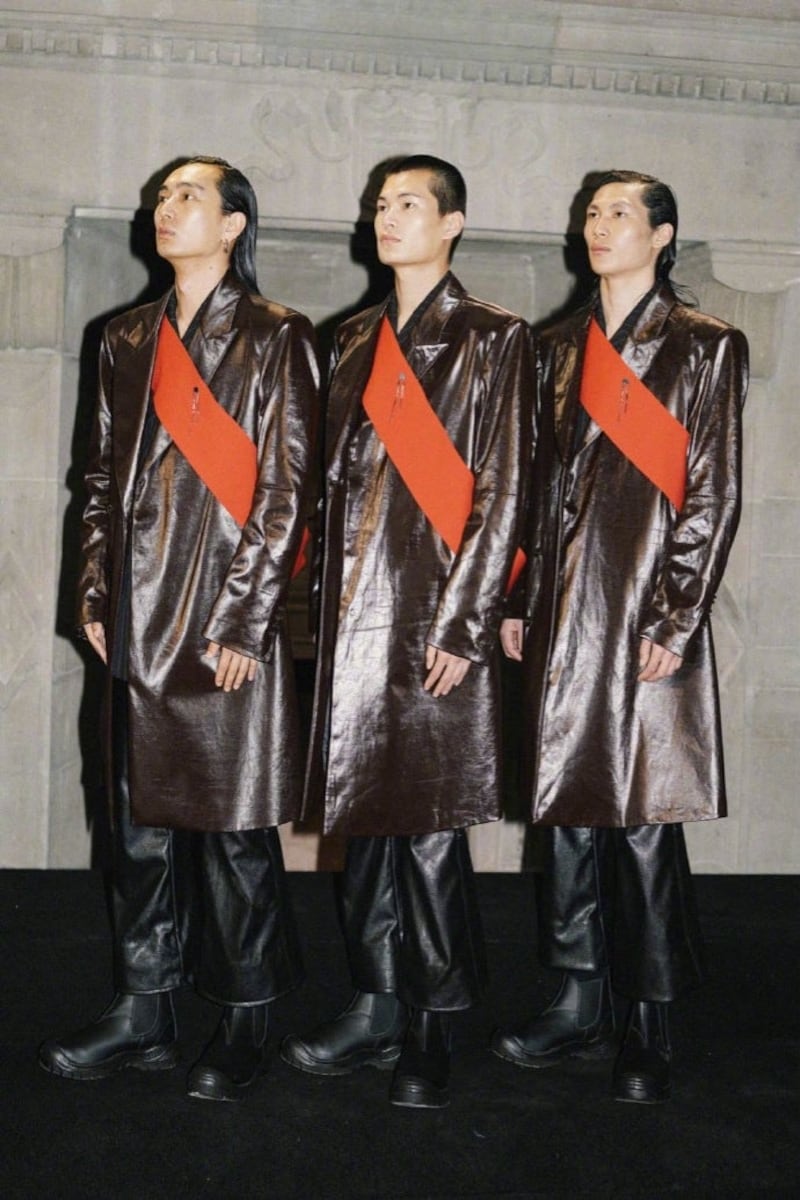
XimonLee's Autumn/Winter 19 collection | Source: Courtesy
Even designers with more wearable looks are riffing on surprising aspects of Chinese culture. Ximon Lee showed a line of cadre-inspired looks informed by China’s political history — still the subject of patriotic blockbuster films here — but steered in a new direction. His show was divided into two factions, those with blue-scarves and grey Sun Yat-sen suits representing nihilism, and those in red sashes and brown leather jackets representing idealism.
Qiu Hao, a member of the older guard of Chinese designers, didn’t create such an elaborate alternate history but he did show a luxurious green fur coat with a black collar that nodded overtly to the heavy great coats worn by the People’s Liberation Army.
“It’s a special language between young designers and their consumers that’s more direct and effective,” said Ontimeshow’s Aroma Xie. She cited Kktp’s allusions to the tracksuits Chinese students wear to secondary school and 5min’s Mahjong Academy collection as examples.
While Chinese designers are increasingly speaking a shared tongue, that’s not to say their ambitions are in any way limited to China. Xia identifies herself as a New York designer, while Qiu Shuting (another finalist of the BoF prize) said “people from all over the world can wear my clothes, but they must be very self-confident, very powerful women.” Nicki Minaj and Rita Ora have all reached out asking to get their hands on her apparel and accessories, she said.
Likewise, China is a vast and increasingly diverse market, and there will always be interest in what’s happening abroad. Foreign brands will continue to play a major role in setting and shaping trends, and there is no question that Shanghai Fashion Week (SHFW) continues to to facilitate that exchange.
On opening night, Future rapped his way down the Xintiandi runway for Reebok — the Boston-based sportswear brand with whom Victoria Beckham collaborated on a new collection earlier this year. American-Chinese designer Vivienne Tam skipped New York Fashion Week, choosing instead to reveal her new collection in an 89-year-old warehouse on the south bank of Shanghai’s Suzhou Creek.
But young Chinese designers are proving that by speaking the local aesthetic language, it pays to be here.
ADVERTISEMENT
And that’s exactly what Reebok has decided to do. While Asia Pacific is Reebok’s third largest regional market, after Europe and North America, the company saw its largest revenue gains here, up 3 percent to $377.9 million in 2018. To keep that momentum growing and future proof its designs, Reebok opened a Creation Centre in Shanghai last year to gather insights on trends in China and develop both apparel and footwear for the Chinese market, according to Reebok president Matt O'Toole. In appreciation of Chinese consumers’ need for speed, Reebok also experimented with a "see now, buy now" sales strategy at SHFW.
While global brands are building up their insight and creative teams in China, not all of them are doing it in a way that will meet the growing expectations of Chinese consumers. Perhaps the final word goes to LVMH group president of Greater China Andrew Wu who warned global brands at the BoF China Summit, "You should not just take the easy way and recruit two Chinese students. They do not represent all of China."
时尚与美容
FASHION & BEAUTY
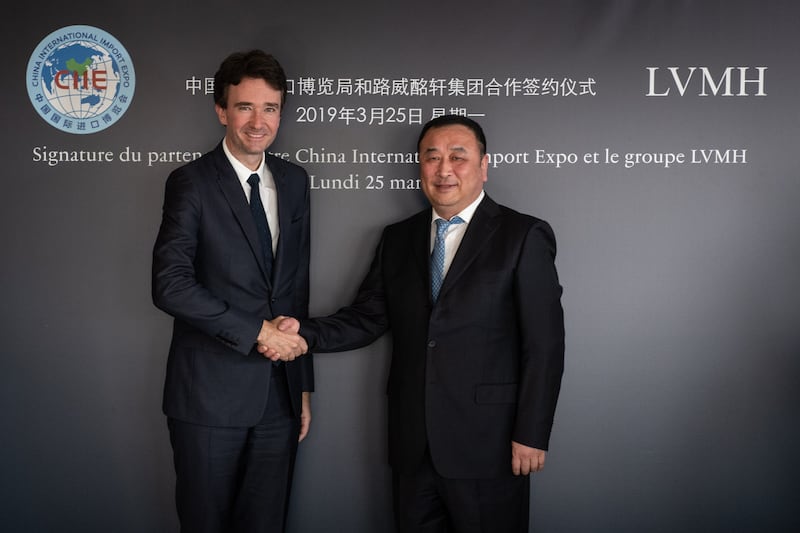
Antoine Arnault of LVMH and Sun Chenghai of CIIE | Source: Courtesy
LVMH to Take Part in Landmark Chinese Import Expo
LVMH will take part in the China International Import Expo (CIIE), slated to kick off November 5 in Shanghai. On March 25, LVMH director and head of communications and image Antoine Arnault signed an agreement with the CIIE Bureau to showcase LVMH products at the trade fair, a linchpin in Beijing's One Belt, One Road initiative aiming to foster trade relationships between Chinese and global enterprises. The move is well aligned with current Beijing-Paris diplomatic relations — President Xi kicked off his official visit to Paris on March 25 (coinciding with the 55th anniversary of diplomacy between the two nations) and French President Emmanuel Macron will travel to China in the fall. (The Paper)
Design Matters at Kering’s Sustainability Forum
During Shanghai Fashion Week, Kering brought its sustainability initiatives to the city for a series of discussions hosted with Plug and Play. The talks, curated by creative agency Yehyehyeh's founder Shaway Yeh, dove into the challenges of innovative materials with executives and creatives such as Labelhood's Tasha Liu and Kering's President for Greater China Jingqing Cai. Yeh stressed the importance of beautiful design in making sustainability covetable, while Geraldine Vallejo, Kering's sustainability program director touched on "Why Materials Matter," saying "we believe at Kering that no animal should suffer for fashion." Meanwhile, during her talk on ocean plastics, Neuni Group founder and chief executive Lyla Wu argued that sustainability is a false proposition unless the industry redefines modern luxury. Though China doesn't come to mind as a pioneering nation in environmental protection, the discussions hinted at a well overdue sea change. "This is a new topic of discussion," said Cai during her introduction. "But it's also attracting a lot of attention — even at the Two Sessions [annual National People's Congress meeting], President Xi said, 'ecological civilisation should start with ecological optimisation.'" (Press Release)
China Alliance Takes Stock in Italian Fashion Capitals
Though Italy signed onto China's flagship One Belt, One Road global infrastructure initiative only last month, the countries' fashion industries are already reflecting this newly strengthened relationship. On March 29, BoF exclusively revealed that China has been named the guest nation for menswear tradeshow Pitto Uomo's 96th edition, which will partner with Shanghai Fashion Week, Tmall and designer incubator Labelhood to bring 11 Chinese designers including Pronounce, Samuel Gui Yang and 8on8 to Florence this June. "China has become one of the most fertile and dynamic territories on a global level for fashion experimentation. That's why we decided, together with the prestigious partners accompanying us in this project, to present eleven of the most innovative Chinese brands to buyers and the international press," said Lapo Cianchi, secretary general of the Fondazione and director of communications and special projects at Pitti Immagine. The same week, it was announced that Alibaba Group's e-commerce arm AliExpress inked a partnership with Altaroma, Rome's biannual fashion week, providing a global gateway for emerging Italian talents by allowing their collections to be sold on AliExpress. (Additional reporting by BoF China's Denni Hu)
科技与创新
TECH & INNOVATION

Huawei and Gentle Monster's upcoming smart eyewear collection | Source: Huawei
Huawei and Gentle Monster to Launch Smart Eyewear
At its press conference in Paris last week, Huawei announced that it will be launching a line of smart glasses in collaboration with high-end Korean eyewear brand Gentle Monster. According to the Chinese telecom giant, the upcoming collection — available after July 2019 — will allow wearers to speak on their phones sans-earbuds, but will not incorporate a camera and could be a big step for the hitherto unfashionable augmented reality wearables market. Evidently, Huawei's entanglement in the current US-China tech war isn't holding it back: just last week, the company announced it made a record $105 billion in revenue in 2018 (a 20 percent year-on-year rise), while revenues from its smartphone division soared by 45 percent. (Technode, The Verge)
As China’s Economy Cools, Start-Ups are Bound to Stumble
Though 2018 was a great year for China's venture capital funding — resulting in an impressive cohort of 97 Chinese unicorns, or companies valued at over $1 billion — a highly sceptical cadre of investors are predicting that up to 90 percent of Chinese start-ups are doomed to fail. Subsequent to the rise and fall of companies such as bike-sharing operator Ofo, property listing platforms Aiwujiwu and Pinganfang, many are arguing that China's tech boom was reliant on its economy, and not by the innovation know-how that sustains tech breakthroughs in countries such as the US and Japan. As such, survivors will need real innovation to distinguish themselves without relying on the sheer size of China's domestic market. (SCMP)
China and US Head-to-Head in App Spending Estimates
According to a new report by app intelligence firm Sensor Tower, consumer spending in mobile apps (across both Apple and Google's app stores) will grow by 120 percent to reach $156 billion worldwide in the next five years. While the firm estimates that China's app store revenues will still reign supreme in 2023, the report forecasts that the US's numbers will briefly pass China's in 2020, due to Beijing's freeze on game licensing and Apple's phone sales slowdown. Even so, the real extent of China's in-app spending remains unclear due to the proliferation of WeChat mini programs — just last month, WeChat continued its spat with Apple over a 30 percent revenue split the latter demanded. (Techcrunch)
消费与零售
CONSUMER & RETAIL
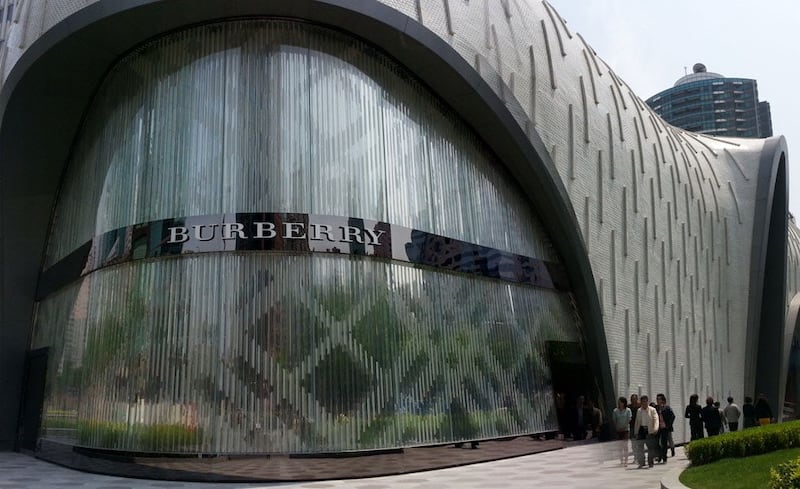
Burberry's recently closed L'Avenue flagship | Source: L'Avenue
With Shuttered Flagship, Burberry Halves Shanghai Presence
On March 31, Burberry's flagship store at Shanghai's L'Avenue mall opened its doors for the last time. The British brand has closed half of its Shanghai stores in the last six months, and in early March, insider sources told local media that the company had gone on to lay off staff until only seven employees remained. According to a Burberry spokesperson, the string of closures is merely indicative of wider operational restructuring, and the brand has announced that it will open two stores in coming months. Even so, other evidence — a revenue slip announced in January and the brand's "creepy" Chinese New Year marketing campaign to name a few — suggest that Burberry's bids on Chinese consumers aren't paying off. (Beijing News)
Peacebird Profits Soar 27 Percent
Chinese fashion group Peacebird's profits soared 27 percent to a record high of 570 million yuan (around $84.9 million) last year, as revealed in an annual report released on March 29. The boost may be the result of the company's aggressive retail strategy, which saw it open 343 stores in shopping centres last year, making up 1,700 malls locations and a total of 4,594 points of sale as of December 2018. Additionally, Peacebird has been honing its millennial-friendly branding strategy through appearances at New York Fashion Week and streetwear media company Yoho!'s Yohood exhibition to give it an edge in China's cutthroat mid-price apparel market. Importantly, Peacebird's childrenswear division is growing rapidly, and realised an operating income of 864 million yuan (around $128.7 million), a 21.85 percent year-on-year increase. (Ebrun)
Galeries Lafayette Test Drives First Shanghai Location
The iconic Parisian department store's first Shanghai outpost, located at the L+ Mall in Pudong, was put into trial operation last week. After a six-storey, 47,000-square meter Beijing location and its presence in Jakarta (both of which opened in 2013), this marks Galeries Lafayette's second Chinese store and third in Asia. Spanning about 25,000 square meters, the Shanghai store will follow in Beijing's shoes as a 50:50 joint venture with Hong Kong-based I.T. With prominent players — from Beijing's SKP and Yintai to Shanghai's K11 mall — dominating China's luxury department store scene with everything from O2O digital offerings to art installations, it remains to be seen how the Parisian icon will make its mark in China's fashion capital. (BoF China)
政治、经济、社会
POLITICS, ECONOMY, SOCIETY
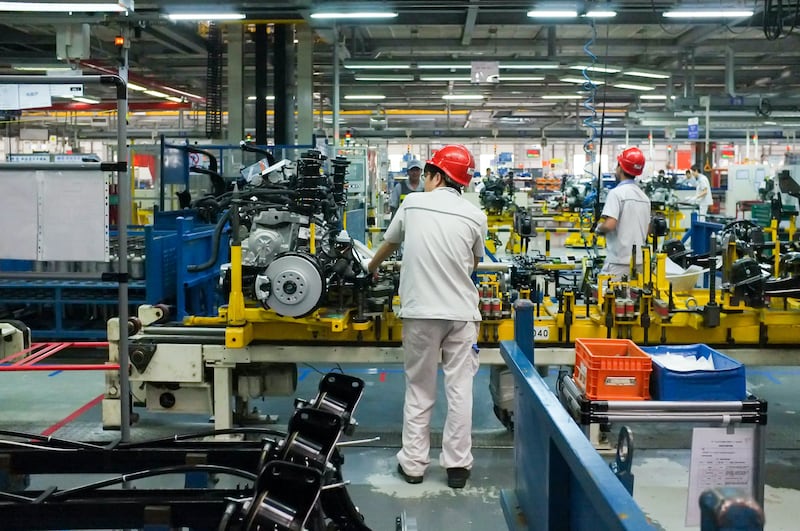
Source: Shutterstock
China’s Manufacturing Bounces Back
The Middle Kingdom's manufacturing sector made an unexpected return to growth last month for the first time in four months, placing expansion at its strongest in eight months. According to the Caixin and Markit Manufacturing Purchasing Managers' Index (PMI) released April 1, the PMI rose to 50.8 from 49.9 in February, beating forecasts by Reuters economists that the reading would remain unchanged. While analysts suggest Beijing's infrastructure investment stimulus can be credited for the healthy PMI, business sentiment is on the mend following Washington and Beijing's trade war talks. Still, it's too soon to tell whether the manufacturing boost is a real turning point or a result of Beijing's new policies — a few more months of data are needed to make that call. (SCMP)
Apple Cuts iPhone Prices in China
Thanks to a tax cut that took effect April 1, Apple has cut the prices of iPhones, iPads and other products, in some cases going beyond the 3 percent-point drop in VAT sales tax. The newest iPhone now costs 8,199 Yuan ($1,220), which is 5.8 percent cheaper for Chinese consumers. According to market research firm IDC, Apple's smartphone sales have slipped in China for over three years and have plunged 20 percent last quarter. Early this year, chief executive Tim Cook warned of the Middle Kingdom's "more severe" macroeconomic headwinds, which was echoed in a warning to investors. Stiff competition from local smartphone makers such as Huawei and Xiaomi (at dramatically lower price-points) could also threaten China's position as a key market for Apple — the company reported that Greater China revenues fell around 27 percent year-on-year last quarter. (CNN)
In Taipei, the Uber Wealthy Hide Their Wealth
Taiwan doesn't scream wealth, but its elite are merely less showy with their fortunes. While Knight Frank predicts that its number of ultra-high-net-worth individuals will rise to 1,864 by 2023, UBS estimates that the Taiwanese hold $500 billion offshore, coming third behind China ($1.4 trillion) and the US ($700 billion). And yet, Taiwanese families don't fit into the stereotypical portrayals of wealthy asians in films such as Crazy Rich Asians. "We are not showy," said Richard Tsai, who co-heads Fubon Financial Holding Co with his brother. "Taiwanese learned the importance of modesty from the Japanese and value the traditional Chinese virtue of humility." (Bloomberg)
China Decoded wants to hear from you. Send tips, suggestions, complaints and compliments to zoe.suen@businessoffashion.com.
With consumers tightening their belts in China, the battle between global fast fashion brands and local high street giants has intensified.
Investors are bracing for a steep slowdown in luxury sales when luxury companies report their first quarter results, reflecting lacklustre Chinese demand.
The French beauty giant’s two latest deals are part of a wider M&A push by global players to capture a larger slice of the China market, targeting buzzy high-end brands that offer products with distinctive Chinese elements.
Post-Covid spend by US tourists in Europe has surged past 2019 levels. Chinese travellers, by contrast, have largely favoured domestic and regional destinations like Hong Kong, Singapore and Japan.